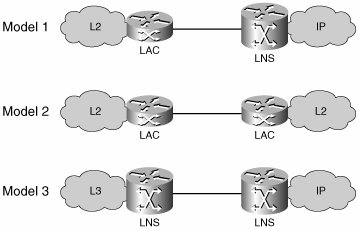Appendix A. L2TPv3 Expanded Coverage
| Layer 2 Tunnel Protocol version 3 (L2TPv3) is an extension of regular L2TP that allows transport of data-link traffic other than PPP. The differences between version 3, defined in RFC 3931, and its previous incarnation are relatively minor and generally involve making the protocol less PPP specific. RFC 3931 lists the major differences from the original specification (RFC 2661, which we probably now need to refer to as L2TPv2):
The L2TPv3 protocol consists of components to bring up, maintain, and tear down sessions. It can also multiplex different Layer 2 streams into a tunnel. The RFC defines three different deployment models for L2TPv3, which are differentiated by the level of protocol processing on each tunnel endpoint. In all three cases, the deployment models refer to an L2TP access concentrator (LAC), which performs cross-connect function in the Layer 2 domain, and the L2TP network server (LNS), which terminates and processes Layer 3. The difference between the deployment models really concerns matching Layer 2 and Layer 3 across an L2TP tunnel. Figure A-1 should make this clearer. Figure A-1. L2TP Deployment Models The deployment models are as follows:
The L2TP protocol has a control- and data-plane stack, as shown in Figure A-2. The next two sections review each one in more detail. Figure A-2. L2TP Control- and Data-Plane Stack (from RFC 3931) |
EAN: 2147483647
Pages: 128

